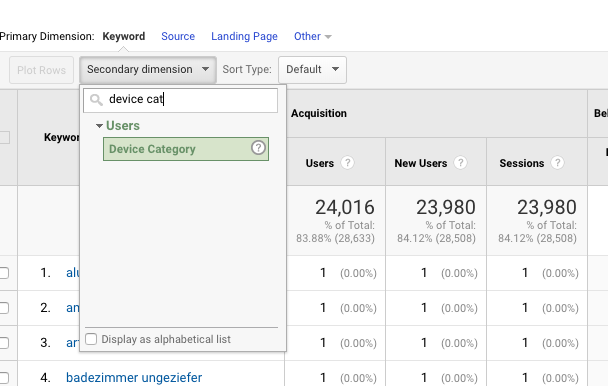Step-by-Step Overview: Leveraging Secondary Dimension in Google Analytics
Optimize Reporting Precision With Additional Dimension in Google Analytics
Understanding just how to take full advantage of reporting accuracy with second dimensions in Google Analytics can significantly boost the deepness of understandings acquired from data analysis. By integrating secondary dimensions purposefully, marketers can discover hidden patterns and connections that might not be promptly apparent when assessing main metrics alone.
Recognizing Additional Measurements in Google Analytics
To boost data analysis and gain much deeper insights right into customer habits, recognizing secondary dimensions in Google Analytics is necessary. Second dimensions allow customers to segment and even more explore information beyond the key dimension selected. By integrating additional measurements, analysts can refine their reports to disclose even more thorough information about customer communications on a site. While the key measurement may display the overall number of web page views, including an additional measurement such as 'source/medium' can provide insights right into where the traffic originated from. This additional layer of details makes it possible for marketers to analyze the effectiveness of various advertising and marketing campaigns or networks in driving web traffic to the site.
Additionally, understanding second measurements is important for creating extra personalized reports customized to specific service goals. By choosing the ideal mix of additional and primary dimensions, experts can reveal patterns, trends, and connections that might otherwise stay surprise. This nuanced method to information evaluation encourages services to make enlightened decisions based on an extensive understanding of user habits across numerous dimensions.

Exactly How to Use Second Dimensions
When leveraging second measurements in Google Analytics, the useful application involves choosing details data parameters to further refine insights past the primary dimension's range. To use additional dimensions properly, start by accessing the record or dataset where you desire to dive deeper into the data. Within Google Analytics, find the main dimension that you are presently assessing. When identified, click on the dropdown food selection classified "Additional Measurement." This action will certainly disclose a checklist of added parameters that can be added to your evaluation. Pick the additional dimension that aligns with your logical goals, such as 'Source/Medium,' 'Device Category,' or 'Area.' By picking a secondary dimension, you can gain more detailed understandings right into individual actions, demographics, or acquisition networks. Bear in mind that additional measurements help offer context and granularity to your primary measurement data, allowing you to extract more workable and significant understandings from your Google Analytics reports.
Leveraging Second Measurements for Insights
Using second measurements in Google Analytics permits an extra comprehensive evaluation of data, offering valuable understandings past the main dimension's range. By leveraging secondary measurements, individuals can delve much deeper into the efficiency metrics of their web site or application, uncovering hidden patterns and fads that may not be immediately noticeable when just checking out have a peek at these guys primary measurements.
One secret benefit of using second dimensions is the ability to segment and filter data more precisely. This can assist marketing professionals and analysts much better recognize the behavior of certain user segments, such as new site visitors versus returning site visitors, or traffic coming from various geographic places.
Furthermore, secondary dimensions make it possible for customers to compare and contrast numerous information factors within the same record, giving a more holistic view of performance (Secondary Dimension in Google Analytics). Coupling the key measurement of landing pages with secondary measurements like tools or demographics can expose which pages are most reliable in involving users on various tools or from different demographic teams.
In significance, leveraging additional dimensions in Google Analytics empowers customers to draw out richer insights from their data, resulting in more educated decision-making and ultimately, improved performance.
Ideal Practices for Second Dimensions
When evaluating information in Google Analytics, including additional measurements successfully enhances the deepness of insights acquired from the main metrics. Choosing pertinent additional dimensions assists in offering context and a more clear understanding of the data being checked out.
In addition, it is suggested to limit the number of second dimensions used in a solitary report to avoid frustrating the analysis with excessive info. Concentrating on a couple of key second dimensions at a time can cause even more focused and workable understandings. Additionally, consider trying out different mixes of second and primary measurements to uncover unique fads and patterns that may not appear when looking at the information alone.
Advanced Analysis Methods With Additional Measurements
Discovering intricate information relationships through the strategic application of secondary dimensions can reveal nuanced insights that elevate the depth of analysis in Google Analytics. By integrating secondary measurements with main information sets, innovative evaluation methods can be utilized to draw try these out out important info.
Additionally, secondary dimensions can enhance the evaluation of conversion paths by providing added context. Comprehending the various touchpoints a customer communicates with prior to converting can be crucial in enhancing the consumer trip - Secondary Dimension in Google Analytics. By utilizing additional measurements to look into specifics such as web traffic sources or gadgets used, marketers can tailor methods to target high-converting networks properly
Verdict

To enhance data evaluation and gain much deeper insights right into individual actions, comprehending secondary measurements in Google Analytics is imperative - Secondary Dimension in Google Analytics. Additional measurements enable customers to segment and additionally study data beyond the main measurement selected. While the primary measurement might present the overall number of page sights, including a secondary measurement such as 'source/medium' can give insights into where the website traffic stemmed from.When leveraging additional dimensions in Google Analytics, the sensible application involves picking specific information parameters to more improve insights past the key dimension's scope. Keep in mind that secondary measurements aid offer context and granularity to your main measurement information, allowing you to extract more actionable and meaningful insights from your Google Analytics records